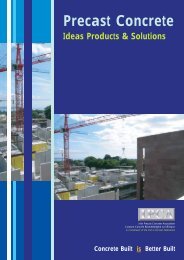Concrete Today May 2010 - the Irish Concrete Federation
Concrete Today May 2010 - the Irish Concrete Federation
Concrete Today May 2010 - the Irish Concrete Federation
Create successful ePaper yourself
Turn your PDF publications into a flip-book with our unique Google optimized e-Paper software.
concrete today - designing for earthquake - precast concrete<br />
Designing for Earthquake – Precast <strong>Concrete</strong><br />
The Importance of <strong>the</strong> conceptual design of precast concrete structures in<br />
seismic areas and lessons from past earthquakes – The SAFECAST Programme<br />
By Georgia Kremmydia, National Technical University of A<strong>the</strong>ns, A<strong>the</strong>ns, Greece<br />
Dipl. Civil Engineer, PhD Candidate<br />
Introduction<br />
In recent years, <strong>the</strong>re has been a sharp<br />
increase in <strong>the</strong> use of prefabricated, offsite<br />
construction techniques, including<br />
Precast concrete. Prefabricated elements,<br />
such as architectural cladding panels,<br />
Precast hollowcore and wideslab floors and<br />
stair flights are also being introduced to<br />
buildings which are primarily constructed<br />
insitu. A shortage of site operatives, <strong>the</strong><br />
need to eliminate uncertainty in <strong>the</strong><br />
programme caused by inclement wea<strong>the</strong>r<br />
conditions and <strong>the</strong> general requirement for<br />
fast, reliable and economic construction<br />
techniques are among <strong>the</strong> main drivers.<br />
Joints and Connections<br />
As is well known, <strong>the</strong> main difference<br />
between traditional, monolithic castinsitu<br />
R.C. structures and corresponding<br />
prefabricated structures, is that <strong>the</strong><br />
latter are composed of several bearing<br />
members cast in a factory ra<strong>the</strong>r than on<br />
site; <strong>the</strong>refore <strong>the</strong> structure is composed<br />
of a set of ‘elements’ which are joined by<br />
‘connections’. Thus <strong>the</strong> main structural<br />
issue in Precast construction relates to <strong>the</strong><br />
connections between Precast members<br />
and to <strong>the</strong> extent to which connections<br />
affect <strong>the</strong> response of <strong>the</strong> total structure<br />
under seismic actions. In this regard, <strong>the</strong><br />
need for Precast structures to satisfy <strong>the</strong><br />
fundamental structural requirements of<br />
‘non collapse’ and ‘damage limitation’ ,<br />
L’Aquila earthquake central Italy 2009<br />
caption<br />
L’Aquila earthquake central Italy 2009<br />
under design-earthquake conditions needs<br />
to be carefully studied.<br />
Experience based on <strong>the</strong> history of seismic<br />
engineering and recent experience of <strong>the</strong><br />
seismic behaviour of R.C. structures, showed<br />
that in spite of <strong>the</strong> enormous development<br />
of computer simulation software, <strong>the</strong><br />
satisfaction of <strong>the</strong> fundamental requirements<br />
under <strong>the</strong> design-earthquake cannot solely<br />
be achieved by means of calculations and<br />
that several basic design concepts proved to<br />
be more important.<br />
Structural simplicity and uniformity<br />
Among <strong>the</strong> most important of <strong>the</strong>se design<br />
concepts is <strong>the</strong> concept of ‘structural<br />
simplicity’ as characterised by ‘uniformity’,<br />
‘symmetry’ and ‘regularity’ in <strong>the</strong><br />
configuration of <strong>the</strong> structural systems in<br />
plan and/or, elevation. This concept should<br />
be addressed in <strong>the</strong> first step of <strong>the</strong> design<br />
process, namely ‘conceptual design’. That<br />
is to say, every analysis has to be carried out<br />
on a preconceived structural scheme.<br />
In fact, by simplifying <strong>the</strong> structural<br />
system, clear and direct paths (including<br />
alternative paths) for <strong>the</strong> transmission of<br />
<strong>the</strong> seismic loads should also be ensured.<br />
In this way, <strong>the</strong> modelling, analysis,<br />
dimensioning and detailing of <strong>the</strong> structure<br />
is subject to less uncertainty and thus <strong>the</strong><br />
prediction of seismic behaviour is much<br />
more reliable.<br />
The ‘in plan regularity’ is primarily a<br />
function of <strong>the</strong> geometrical configuration<br />
of <strong>the</strong> building: <strong>the</strong> configuration should<br />
be compact and clear. In plan set-backs<br />
(re-entrant corners or edge recesses) or L,<br />
n, E or - L shapes etc. should be avoided,<br />
or o<strong>the</strong>rwise limited and specially treated.<br />
• The ratio of Lmax: Lmin. should not be<br />
less than 4<br />
• The distribution of <strong>the</strong> lateral stiffness<br />
concrete today<br />
5





